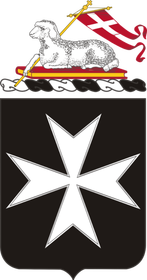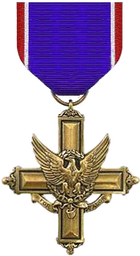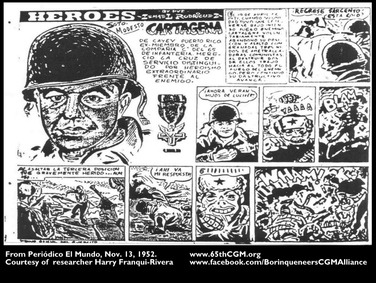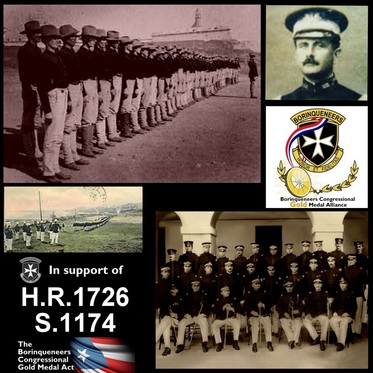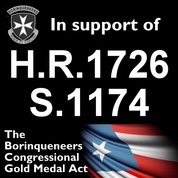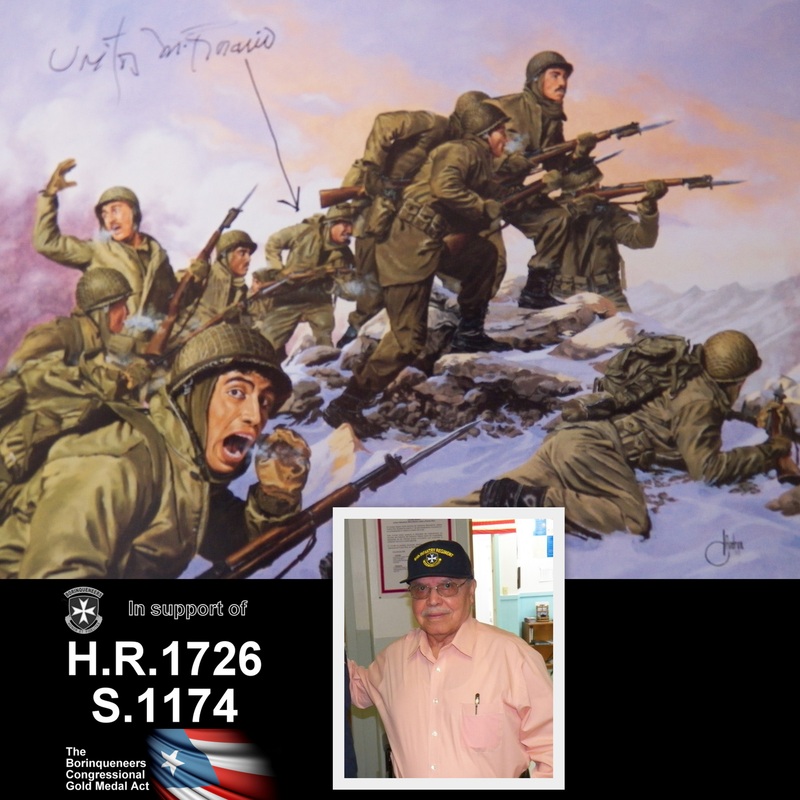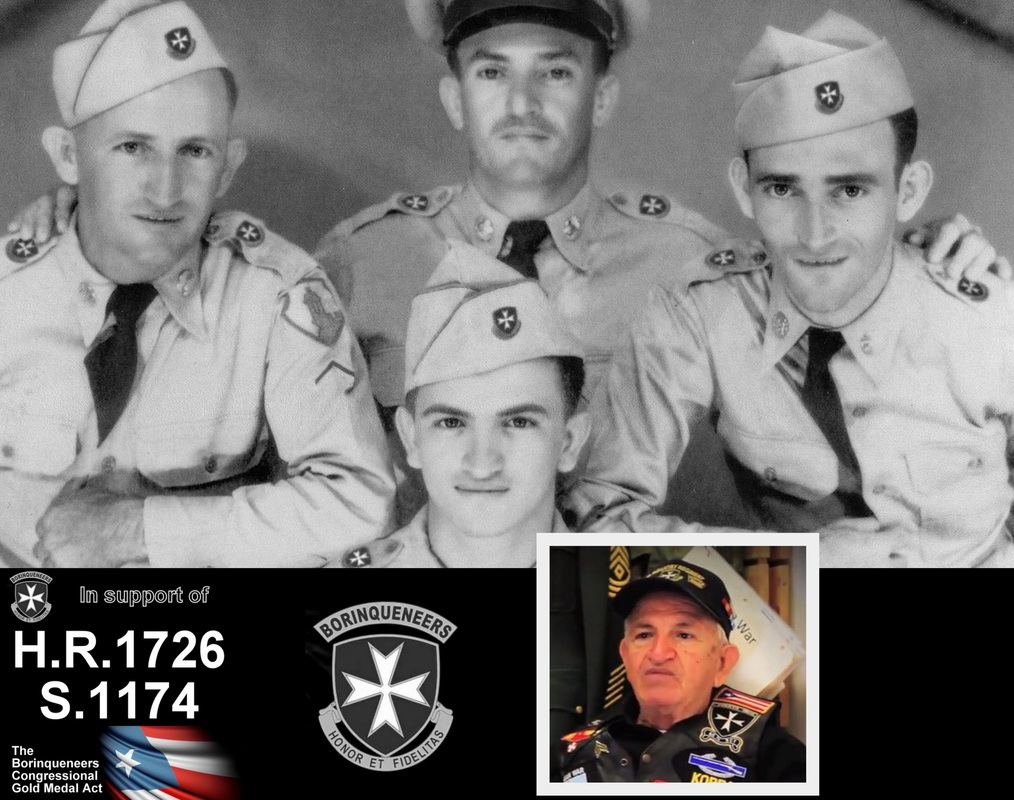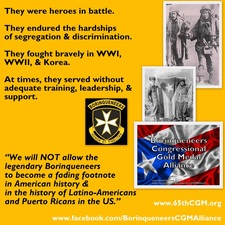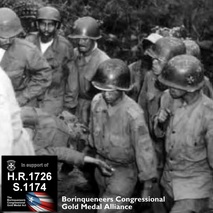More Borinqueneers history...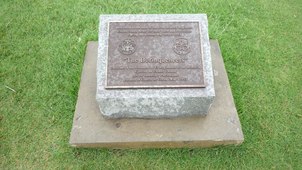 Borinqueneers plaque at El Morro.
Borinqueneers Congressional Gold Medal Alliance will be adding new historical highlights of the Borinqueneers as time moves forward.
If you have any photographs or items that you would like to share, please see our Contact Us page. You can either email materials, or upload them via the contact form. Thank you! Tuskegee Airmen and Puerto Ricans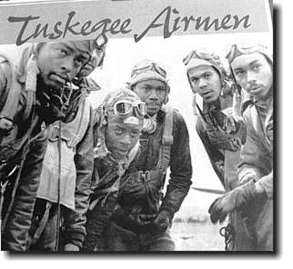
Puerto Ricans also served in the United States Army Air Forces. In 1944, Puerto Rican aviators were sent to the Tuskegee Army Air Field in Tuskegee, Alabama to train the famed 99th Fighter Squadron of the Tuskegee Airmen. The Tuskegee Airmen were the first African-American military aviators in the United States armed forces. Puerto Ricans were also involved in clerical positions with the Tuskegee unit. Among the Puerto Ricans who helped make the Tuskegee experiment a successful one were T/Sgt. Pablo Diaz Albortt, an NCO (Non Commissioned Officer) in charge of the Special Service Office, and Eugene Calderon, who was assigned to the "Red Tail" unit, as the Company Clerk. By the end of the war, the Tuskegee Airmen were credited with 109 Luftwaffe aircraft shot down, a patrol boat run aground by machine-gun fire, and destruction of numerous fuel dumps, trucks and trains.
442nd Nisei (Japanese) Soldiers & 65th Infantry Regiment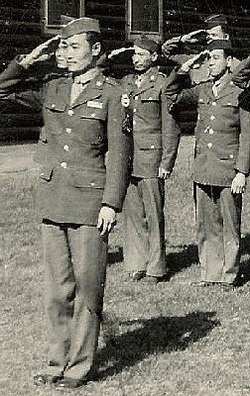
Lieutenant Colonel Juan Cesar Cordero, a Puerto Rican National Guard officer, commanded the 3d Battalion in combat. The 40-year old officer was a graduate of the University of Puerto Rico and Mayaguez’s College of Agriculture and Mechanical Arts, where he had received his Reserve Commission as a second lieutenant. His battalion had relieved the 2nd Battalion of the 442nd Infantry Regiment, a Regiment which was made up of Japanese Americans under the command of Col. Virgil R. Miller, also a native of Puerto Rico on 13 December. The 442nd Regimental Combat Team was on the 65th Infantry’s right, while the 899th Anti-Aircraft Artillery Battalion, fighting as infantry, was on the left. Facing the regiment was the German 34th Infantry Division’s 107th Infantry Regiment. During the month the Puerto Ricans participated in a number of small unit engagements at Turini, Epinal-Chenimenil, and Leintray. The 3rd Battalion fought against and defeated Germany's 34th Infantry Division's
107th Infantry Regiment. There were 47 battle casualties, including Private Sergio Sanchez-Sanchez and Sergeant Angel Martinez from the town of Sabana Grande, who became the first two Puerto Ricans to be killed in combat action from the 65th Infantry as a result of a German assault on Company "L". "Fijar bayonetas!" ("Fix bayonets!")
Operation PORTREX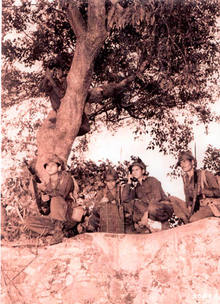 Operation PORTREX won by the 65th!
One of the pinnacle achievements of the 65th Infantry Regiment Borinqueneers was the Operation PORTEX military exercise held on the island of Vieques before the Korean War.
The Borinqueneers prevented more than 32,600 combat troops from the US Army & US Marine Corps, who were aided by Naval & Air forces, from establishing a beachhead on the island. This victory confirmed the Borinqueneers as a potent fighting force to be reckoned with. They were soon on their way to Korea. Pacific Stars & Stripes:
|
Mambo on Hill 167
 Click on pic to enlarge! Click on pic to enlarge!
“Many officers at the time thought it was the kiss of death to be assigned to the Puerto Rican Regiment. Critics called it the “seeeexty feeeeth” mockingly imitating the Spanish accent of most of the regiment’s Puerto Rican soldiers.” “No platoon member living or dead was left behind.” “Arriba muchachos!” “One general called it a regiment of “colored” troops, unreliable and inferior to continental “white” soldiers.” - from Mambo on Hill 167, a captivating story of heroism & sacrifice despite prejudice, by Bart Soto, alliance national steering committee member, author, & historian. Follow this link to read the story & learn more about the legendary 65th Inf. Reg. Borinqueneers in our Special Hispanic Heritage Report! Two Silver Stars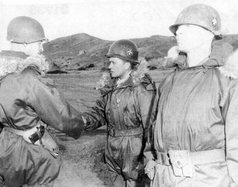 2nd Lt. Vidal Rodriguez Amaro
Borinqueneer 2nd Lt. Vidal Rodriguez Amaro received the Silver Star Medal with Oak Leaf Cluster (2nd Silver Star) on January 26, 1953. The citation reads as follows:
"The President of the United States takes pleasure in presenting an Oak Leaf Cluster in lieu of a Second Silver Star Medal to Vidal Rodriguez-Amaro (0-12034123), Second Lieutenant (Infantry), U.S. Army, for conspicuous gallantry and intrepidity in action while serving with Company I, 3d Battalion, 65th Infantry Regiment, 3d Infantry Division. On the morning of 26 September 1952, a platoon of Company I, led by Lieutenant Rodriguez-Amaro, was assigned the mission of making contact with and locating enemy positions on a hill known as KELLY in the vicinity of Koyangdae, Korea. While leading his men to the crest of the hill, Lieutenant Rodriguez-Amaro sustained a serious leg wound when the friendly unit was subjected to intense hostile machine gun fire. Disregarding his painful wound and ignoring the heavy hostile fire, he ordered his men to fix bayonets and fearlessly continued in the attack. The foe immediately counteracted the bayonet charge by subjecting the friendly forces to an intense barrage of mortar and artillery fire. Realizing that it would be fatal to continue in the attack in the face of such devastating fire, Lieutenant Rodriguez-Amaro ordered his men to withdraw. Refusing medical aid and evacuation, he directed the withdrawal of his unit. Upon seeing a wounded soldier that was unable to participate in the retrograde, he selflessly and with complete disregard for his personal safety, carried the casualty through the shrapnel torn area towards a position of safety. During this act, he received additional wounds of a serious nature but again refused medical aid and evacuation until all friendly casualties had been removed to positions of safety. Lieutenant Rodriguez-Amaro's outstanding gallantry and inspirational leadership were highly instrumental in the unit successfully accomplishing its mission and reflect the highest credit upon himself and the military service. Home Of Record: Puerto Rico" |
- Bienvenidos!
- In The News! +
- faq
- Census
- Donate
- 65th Inf. Memorials
- Products
- About Us
- 65th Infantry Historia
- CGM Design
- Call Congress Now!!
- Bill Co-Sponsor Countdown
- Endorsements & Support
- Proclamations & Resolutions
- Latino Heroes!
- Contact Us!
- Blumenthal
- Hispanic Heritage Awards Borinqueneers Tribute
- CGM Ceremony Updates
- HHM

